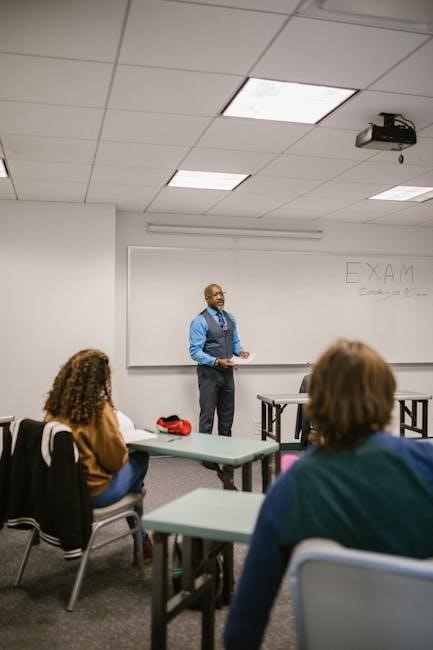The flight instructor oral exam evaluates a candidate’s knowledge, critical thinking, and communication skills, ensuring they can effectively teach and apply aviation principles safely and confidently․
1․1․ Overview of the Oral Exam Process
The oral exam is a critical assessment where candidates demonstrate their knowledge, critical thinking, and communication skills․ Conducted by a certified examiner, it evaluates the candidate’s ability to apply aviation principles and safety protocols․ The process involves scenario-based questions, real-world applications, and problem-solving exercises․ Candidates must articulate their understanding clearly and confidently, showcasing their readiness to instruct safely and effectively․ The exam also ensures candidates can think critically and make sound decisions under various flight scenarios, aligning with Federal Aviation Regulations and industry standards․ Proper preparation and understanding of aircraft systems, weather, and regulations are essential for success․
1․2․ Importance of Preparation
Preparation is crucial for the flight instructor oral exam as it ensures a deep understanding of aviation principles and regulations․ Adequate study helps candidates articulate their knowledge clearly and confidently, demonstrating their ability to teach and apply safety protocols effectively․ Without proper preparation, candidates risk failing to address critical scenarios, leading to exam failure․ Thorough review of aircraft systems, weather, and emergency procedures is vital․ Preparation also enhances critical thinking and communication skills, essential for success in the oral exam and real-world instruction․
1․3․ Common Challenges Candidates Face
Candidates often struggle with nerves and articulating complex concepts clearly․ Many find it difficult to apply theoretical knowledge to practical scenarios under exam pressure․ Time management during the oral exam is another hurdle, as candidates must address questions efficiently․ Additionally, some may lack confidence in their teaching techniques or fail to anticipate unconventional questions․ These challenges highlight the need for thorough preparation and practice to ensure clarity, composure, and the ability to think critically during the exam․

Understanding the Exam Format
The oral exam is an interactive Q&A session with an examiner, focusing on scenario-based questions and theoretical knowledge․ Candidates must articulate their thoughts clearly and logically․
2․1․ Structure of the Oral Exam
The oral exam typically begins with an introduction, followed by structured questioning․ The examiner assesses knowledge and problem-solving skills through scenario-based discussions․ Candidates are evaluated on their ability to articulate concepts clearly and logically․ The exam may include questions about aircraft systems, weather, regulations, and safety procedures․ The structure ensures a comprehensive assessment of both theoretical knowledge and practical application․ Time management is crucial, as the exam follows a set format with specific time allocations for each section; Candidates must remain focused and organized to cover all topics efficiently․
2․2․ Types of Questions to Expect
The oral exam includes a variety of question types, such as direct questions, scenario-based inquiries, and open-ended discussions․ Candidates may be asked to explain complex concepts, such as aircraft systems or weather interpretation, in detail․ Scenario-based questions test decision-making skills, like handling emergencies or navigating in adverse conditions․ Examiners also assess teaching techniques, asking how candidates would explain topics to students․ The questions are designed to evaluate both technical knowledge and the ability to apply it practically․ Being prepared for diverse question formats is essential for success․
2․3․ Time Management Strategies
Effective time management is crucial during the oral exam to ensure all topics are covered thoroughly․ Candidates should prioritize questions based on complexity and allocate time accordingly․ Practicing under timed conditions helps build familiarity with the exam’s pace․ Staying calm and organized allows for clear, concise responses․ Avoid spending too long on a single question—move forward and return if time permits․ Using mental or written notes can help track progress․ The goal is to demonstrate knowledge efficiently while maintaining composure․ Proper time management enhances performance and ensures a positive impression on the examiner․

Key Topics Covered in the Oral Exam
The oral exam covers aircraft systems, weather, regulations, safety procedures, aerodynamics, navigation, and communication, ensuring comprehensive knowledge essential for effective flight instruction and student safety․
3․1․ Aircraft Systems and Performance
Understanding aircraft systems and performance is critical for flight instructors․ This includes knowledge of engine operation, fuel systems, electrical systems, and hydraulic systems․ Candidates must explain how these systems interact and affect aircraft performance․ Topics like climb rates, cruise speeds, and range calculations are also covered․ Instructors should be able to discuss factors influencing performance, such as weight, altitude, and weather conditions․ Additionally, they must demonstrate an understanding of aircraft limitations and how to optimize performance for various flight scenarios․ This knowledge ensures instructors can provide accurate guidance and make informed decisions during training․
3․2․ Weather and Flight Planning
Weather and flight planning are essential topics in the oral exam․ Candidates must demonstrate understanding of meteorological reports, forecasts, and conditions affecting flight safety․ This includes interpreting METARs, TAFs, and wind aloft data․ Instructors should explain how weather influences aircraft performance, such as icing conditions or thunderstorms․ Additionally, they must discuss flight planning strategies, including route selection, fuel calculations, and contingency plans․ Understanding weather-related decision-making, like choosing alternate airports or delaying departure, is crucial․ Proficiency in using tools like E6B calculators or electronic flight planners is also expected to ensure safe and efficient flight operations․
3․3․ Regulations and Aviation Law
Understanding regulations and aviation law is critical for flight instructors․ Candidates must demonstrate knowledge of Federal Aviation Regulations (FARs), including Part 61 (certification of pilots) and Part 91 (general operating rules)․ They should explain the role of the FAA, airspace classifications, and rules for VFR and IFR flights․ Additionally, instructors must discuss international aviation laws and ICAO standards․ Knowledge of aircraft airworthiness, maintenance requirements, and compliance with safety protocols is essential․ Familiarity with recent regulatory changes and their impact on flight training is also expected․ This ensures instructors can teach students to operate legally and safely within aviation frameworks․
3․4․ Safety Procedures and Emergency Protocols
Safety procedures and emergency protocols are vital for flight instructors to master․ Candidates should explain pre-flight safety checks, emergency equipment usage, and procedures for scenarios like engine failure or system malfunctions․ They must discuss evacuation protocols, fire management, and first aid․ Instructors should also outline steps for handling medical emergencies, weather-related threats, and aircraft contamination․ Understanding these protocols ensures instructors can train students to respond effectively in critical situations, minimizing risks and saving lives․ Proficiency in these areas is essential for maintaining safety and confidence in flight training environments․
3․5․ Aerodynamics and Flight Mechanics
Aerodynamics and flight mechanics are fundamental to understanding aircraft behavior․ Candidates should discuss lift generation, drag factors, and thrust principles․ Key concepts include Bernoulli’s principle, airfoil design, and angle of attack․ They must explain how weight, lift, thrust, and drag interact during flight․ Additionally, instructors should cover stalls, spins, and aerodynamic efficiency․ Understanding these principles helps in analyzing aircraft performance, optimizing maneuvers, and ensuring safe operations․ Proficiency in aerodynamics is essential for instructors to teach students how to control and navigate aircraft effectively in various conditions․
3․6․ Navigation and Communication
Navigation and communication are critical skills for flight instructors to master․ Candidates should demonstrate knowledge of navigation systems, including VOR, GPS, and NDB․ They must explain how to interpret charts, use waypoints, and apply dead reckoning․ Communication involves understanding ATC protocols, standard phraseology, and emergency procedures․ Instructors should emphasize clear and concise radio interactions, adherence to airspace rules, and the importance of situational awareness․ Proficiency in these areas ensures safe and effective flight operations, making them essential topics for the oral exam․

The Role of a Flight Instructor
A flight instructor teaches, trains, and mentors students to become competent pilots․ Key responsibilities include lesson planning, safety oversight, and assessing student progress․ Effective communication and patience are essential․
4․1․ Responsibilities and Duties
A flight instructor’s primary duty is to teach students safely and effectively, ensuring they meet aviation standards․ This includes lesson planning, conducting pre-flight briefings, and demonstrating maneuvers․ They assess student progress, provide feedback, and maintain training records․ Instructors must stay updated on aviation regulations and weather conditions to ensure safe flight operations․ They also conduct post-flight reviews and recommend areas for improvement․ Additionally, they foster a positive learning environment, encouraging student confidence and professionalism․ These responsibilities require strong communication, patience, and the ability to adapt to individual learning styles․
4․2․ Qualities of an Effective Instructor
An effective flight instructor possesses a combination of patience, strong communication skills, and adaptability to cater to diverse learning styles․ They must have deep knowledge of aviation principles and the ability to simplify complex concepts․ Enthusiasm and empathy help build rapport with students, fostering confidence and engagement․ Effective instructors provide clear, constructive feedback and remain calm under pressure․ Their passion for teaching and aviation inspires students to excel․ These qualities ensure a safe, productive, and encouraging learning environment, essential for successful flight training․
4․3․ Building Student Confidence
Building student confidence is crucial for effective flight training․ Instructors should foster a supportive environment where students feel comfortable asking questions and making mistakes․ Positive reinforcement, such as praising progress, helps students gain self-assurance․ Tailoring lessons to individual needs ensures students master skills at their own pace․ Demonstrating techniques and allowing practice under guidance can enhance their confidence․ Clear feedback and encouragement are essential․ Gradually increasing responsibility as students improve helps them feel capable․ Creating a positive, patient, and encouraging atmosphere is key to developing confident pilots․

Preparing for the Oral Exam
Preparing for the oral exam requires a structured approach․ Review flight manuals, practice mock exams, and stay updated on aviation regulations․ Diligent preparation builds confidence and ensures success․
5․1․ Study Materials and Resources
Essential study materials include the Pilot’s Operating Handbook (POH), FAA regulations (FAR/AIM), and the Aviation Instructor’s Handbook․ Additionally, review aircraft performance charts, weather briefings, and navigation tools․ Utilize online resources like FAA․gov for training materials and guides․ Consider flight instructor-specific study guides, which often include sample questions and exam tips․ Organize your materials by topic, such as aerodynamics, weather, and regulations, to streamline your study process․ Regularly review and update your resources to ensure accuracy and relevance․ These materials will serve as the foundation for your preparation and confidence․
5․2․ Practice Techniques and Mock Exams
Effective practice involves simulating real exam conditions through mock oral exams with certified instructors or mentors․ Record sessions to identify weaknesses and improve communication skills․ Focus on articulating complex concepts clearly and concisely․ Use flashcards to drill key topics like regulations, weather, and aircraft systems․ Practice explaining scenarios, such as emergency procedures, to build confidence․ Regularly review and refine your answers to ensure accuracy and clarity․ Mock exams help familiarize you with the exam format and reduce anxiety․ Consistent practice strengthens your ability to think critically and respond effectively under pressure․
5․3․ Understanding the Examiner’s Expectations
Examiners assess not only your knowledge but also your ability to apply it practically․ They expect clear, concise, and confident responses, demonstrating a deep understanding of aviation principles․ Be prepared to explain concepts logically and relate them to real-world scenarios․ Focus on showing how you would teach and safety considerations․ Anticipate detailed questions and ensure your answers are thorough․ Practice articulating complex ideas simply, as this reflects effective instructional skills․ Understanding these expectations helps tailor your preparation and delivery, ensuring alignment with what examiners value most: competence, clarity, and the ability to communicate effectively․

Common Mistakes to Avoid
Overlooking key topics, poor communication, and inability to think critically are common pitfalls․ Address these by thorough preparation and practice to ensure a successful exam outcome․
6․1․ Lack of Knowledge on Key Topics
Lack of knowledge on critical areas like aircraft systems, weather, and regulations is a major pitfall․ Candidates must thoroughly study FAA materials, aircraft manuals, and relevant textbooks․ Failing to understand core concepts can lead to incorrect answers and exam failure․ Regular review and practice are essential to ensure a strong foundation․ Focus on high-probability topics and seek clarity on complex subjects․ Inadequate preparation can result in unsafe teaching practices, emphasizing the importance of deep understanding over memorization․ Stay updated with the latest aviation standards and guidelines to avoid gaps in knowledge․
6․2․ Poor Communication Skills
Poor communication skills can significantly hinder performance during the oral exam․ Candidates must clearly articulate their knowledge and reasoning․ Rambling, vague, or disorganized responses can lead to misunderstandings and lower scores․ Practice speaking confidently and concisely, ensuring key points are emphasized․ Recording and reviewing mock interviews can help identify areas for improvement․ Effective communication demonstrates both knowledge and the ability to teach, which is critical for a flight instructor․ Addressing this skill through practice and feedback is essential to succeed in the exam and beyond․
6;3․ Inability to Think Critically
The inability to think critically during the oral exam can lead to inadequate responses, as candidates may struggle to analyze scenarios or justify decisions․ Critical thinking is essential for evaluating complex situations, such as emergency procedures or weather-related risks․ Candidates must demonstrate the ability to assess problems, identify solutions, and explain their reasoning logically․ Practicing scenario-based exercises and reviewing case studies can improve this skill․ Without strong critical thinking, candidates may fail to meet the examiner’s expectations, as this skill is vital for both the exam and real-world instructing responsibilities․

Building Confidence and Reducing Anxiety
Building confidence and reducing anxiety require strategic preparation, positive self-talk, and mental visualization․ Controlled breathing and realistic expectations also help candidates stay calm and focused during the exam․
7․1․ Mindset and Mental Preparation
A positive mindset is crucial for success in the oral exam․ Candidates should focus on mental preparation by embracing a growth mindset, believing in their abilities, and visualizing success․ Practicing positive affirmations and reframing nervousness as excitement can enhance confidence․ Mental rehearsal of potential scenarios helps build familiarity and reduces anxiety․ Additionally, setting realistic expectations and focusing on progress rather than perfection fosters resilience․ A well-prepared mindset allows candidates to approach the exam calmly, think clearly, and demonstrate their knowledge effectively․ Consistent mental practice strengthens self-assurance and readiness for the challenges of the oral exam․
7․2․ Breathing Techniques and Relaxation
Effective breathing techniques are essential for relaxation during the oral exam․ Deep breathing exercises, such as the 4-7-8 method, can calm the nervous system by inhaling for four seconds, holding for seven, and exhaling for eight․ Progressive muscle relaxation can also reduce tension by tensing and releasing muscle groups․ These practices help maintain focus and composure, allowing candidates to articulate their thoughts clearly․ Regular relaxation exercises before the exam can build a habit of calmness, ensuring a steady demeanor under pressure․ By managing stress, candidates can present their knowledge confidently and professionally․
7․3․ Positive Self-Talk and Visualization
Positive self-talk and visualization are powerful tools to enhance confidence and mental clarity during the oral exam․ Affirmations like “I am well-prepared” or “I can handle this” reinforce self-belief․ Visualization involves mentally rehearsing successful scenarios, such as answering questions confidently or handling challenging situations effectively․ These techniques help reduce anxiety and foster a positive mindset․ By consistently practicing positive self-talk and visualization, candidates can cultivate resilience and project confidence, enabling them to perform at their best during the exam․ These practices complement other strategies, ensuring a composed and focused demeanor․

Exam Day Strategy
Arrive early, organize materials, and stay calm․ Review key topics mentally, listen carefully to questions, and answer confidently․ Manage time effectively and follow procedures․
8․1․ Arrival and Initial Setup
Arrive early to account for unexpected delays and complete any necessary paperwork․ Organize your materials, such as certificates, logbooks, and study notes, for quick access․ Greet the examiner confidently and introduce yourself clearly․ Ensure your seating and surroundings are comfortable to maintain focus․ Take a few deep breaths to calm your nerves and mentally prepare for the session․ A positive attitude and organized setup will help you present yourself professionally and set a strong foundation for the exam․
8․2․ Handling the Exam Environment
Upon entering the exam room, remain calm and composed․ Familiarize yourself with the setup to minimize distractions․ Maintain eye contact with the examiner to show confidence and engagement․ Speak clearly and at a moderate pace, ensuring your responses are audible and articulate․ If unsure about a question, ask for clarification politely․ Avoid fidgeting or nervous habits that may detract from your professionalism․ Stay focused on the conversation and address each topic methodically․ Demonstrating self-assurance and adaptability in the exam environment will enhance your performance and leave a positive impression on the examiner․
8․3․ Post-Exam Procedures
After completing the oral exam, exit the room calmly and wait for the examiner’s decision․ Once the results are announced, listen carefully to any feedback provided․ If successful, you will receive a temporary certificate and instructions for the next steps․ If unsuccessful, review the areas needing improvement and schedule a retest within the allowed timeframe․ Regardless of the outcome, maintain professionalism and thank the examiner for their time․ Collect your belongings and follow any additional procedures outlined by the testing center․ Stay patient and focused as you await official confirmation of your results․

Continued Development and Growth
Continued development ensures instructors stay updated on aviation advancements, refine teaching methods, and adapt to evolving standards, fostering professional growth and effectiveness in mentoring future pilots․
9․1․ Ongoing Learning and Improvement
Ongoing learning is crucial for flight instructors to maintain expertise and adapt to industry changes․ Regularly reviewing aviation regulations, aircraft systems, and weather forecasting ensures instructors stay current․ Engaging in workshops, online courses, and peer discussions enhances teaching skills and knowledge․ Continuous improvement also involves reflecting on feedback from students and examiners to refine instructional methods․ By committing to lifelong learning, instructors not only meet certification requirements but also inspire confidence in their students and contribute to safer, more effective flight training environments․ This dedication fosters professional growth and excellence in aviation education․
9․2․ Seeking Feedback and Mentorship
Seeking feedback and mentorship is essential for growth as a flight instructor․ Receiving constructive criticism from examiners or experienced instructors helps identify areas for improvement․ Mentorship provides guidance on teaching techniques, exam strategies, and professional development․ Actively pursuing feedback fosters a culture of continuous improvement, enhancing both instructional skills and exam performance․ Engaging with professional networks and instructors can also offer valuable insights and support․ By embracing feedback and mentorship, candidates can refine their approach, build confidence, and achieve long-term success in their aviation careers․
9․3․ Staying Updated with Aviation Regulations
Staying updated with aviation regulations is crucial for flight instructors, as these rules frequently change․ Regularly reviewing official sources like the Federal Aviation Regulations (FARs) ensures compliance and knowledge of the latest standards․ Subscribing to updates from aviation authorities and attending workshops helps instructors stay informed․ Additionally, joining professional organizations provides access to resources and networking opportunities․ Understanding regulatory changes is not only essential for passing the oral exam but also for maintaining professionalism and providing accurate guidance to students․ Continuous awareness of aviation law ensures instructors remain competent and up-to-date in their field․

Additional Resources and References
Utilize FAA publications, aviation books, and online forums for comprehensive preparation․ Professional memberships and instructor networks offer valuable insights and updated materials for exam success․
10․1․ Recommended Reading Materials
Essential resources include the FAA’s Aeronautical Information Manual (AIM) and Pilot’s Handbook of Aeronautical Knowledge (PHAK)․ Textbooks like The Pilot’s Encyclopedia of Aeronautical Knowledge and Instrument Flying Handbook are invaluable․ Additionally, Weather for Pilots and Aircraft Performance and Design provide in-depth knowledge․ Online resources such as aviation study guides and exam-specific workbooks offer practical insights․ These materials cover key topics and prepare candidates for the oral exam effectively, ensuring a strong foundation for success․
10․2․ Online Courses and Tutorials
Enrolling in online courses and tutorials is a highly effective way to prepare for the oral exam․ Platforms like King Schools, Sporty’s Academy, and Udemy offer comprehensive programs tailored for flight instructors․ These courses often include video lessons, practice exams, and interactive quizzes․ Additionally, websites like Coursera and Aviation eLearning provide specialized modules on aviation regulations, weather, and aircraft systems․ These resources simulate real exam scenarios and help candidates refine their knowledge and communication skills, ensuring they are well-prepared for the oral exam environment․
10․3․ Professional Organizations and Networks
Joining professional organizations and networks can significantly enhance your preparation for the oral exam․ Groups like the Aircraft Owners and Pilots Association (AOPA) and the Society of Aviation and Flight Educators (SAFE) provide valuable resources, workshops, and networking opportunities․ These organizations often host seminars, webinars, and forums where instructors share insights and strategies for succeeding in oral exams․ Building connections with experienced instructors can also provide mentorship and personalized advice․ Engaging with these networks ensures access to updated materials and expert guidance, helping you stay informed and confident throughout your preparation journey․


